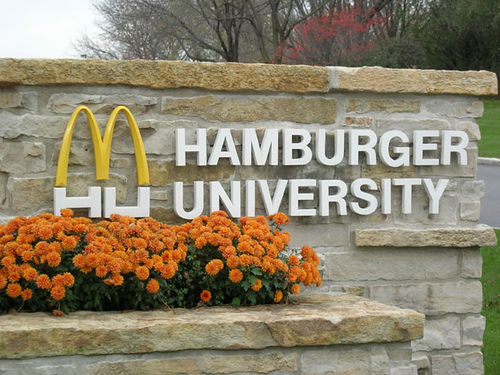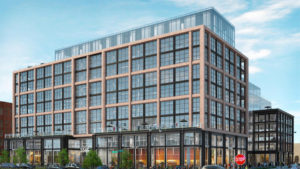In Chicago, Illinois, McDonald’s has joined a slew of other companies that are abandoning both pleasant-but-sterile suburbs and non-sterile-but-struggling rural towns for the increasingly-vibrant big city. Nearly 50 companies have reestablished their headquarters in or near Chicago’s loop.
In 2016, they announced that they were putting their long-time, 86-acre, Oak Brook headquarters property–which includes their famous Hamburger University that has seen some 80,000 students over the decades–up for sale.
They’re moving to the West Loop of Chicago where “L” trains arrive every few minutes and where construction cranes dot the skyline. The site of McDonald’s new headquarters, being built in place of the studio where Oprah Winfrey’s show was filmed, is in Fulton Market, a bustling neighborhood filled with new apartments and some of the city’s most highly rated new restaurants.
Others joining the suburb-to-downtown migration in Chicago include food giant Kraft Heinz, farming supplier ADM, and telecommunications firm Motorola Solutions. They are all looking to appeal to–and be near–young professionals versed in the world of e-commerce, software analytics, digital engineering, marketing and finance.
Such relocations are happening all across the country, as economic opportunities shift to a handful of top cities and jobs become harder to find in some suburbs and smaller cities. In Rhode Island, Hasbro has moved 350 suburban jobs to downtown Providence.
Chicago Mayor Rahm Emanuel said the old model where executives chose locations near where they wanted to live has been upturned by the growing influence of technology in nearly every industry. Years ago, IT operations were an afterthought. Now, people with such expertise are driving top-
level corporate decisions, and many of them prefer urban locales.
Chicago’s arrival as a magnet for corporations belies statistics that would normally give corporate movers pause. High homicide rates and concerns about the police department have eroded Emanuel’s popularity locally. But those issues seem confined to other parts of the city as young professionals crowd into the Loop, Chicago’s lively central business district. “Corporations tell me the number one concern that they have — workforce,” Emanuel said.
The migration to urban centers threatens the prosperity outlying suburbs have long enjoyed, and also brings a dose of pain to more-isolated rural communities.
And it’s not just large employers who are moving, either. Ryan Woodings owns a 15-person tech startup in Boise, Idaho. His company, MetaGeek, specializes in helping businesses fix and maintain their Wi-Fi systems. As the company grew out of its initial operations in his home, it moved into an actual office in a suburban neighborhood on the outskirts of Boise.
But that location posed some problems. Foremost among them was what might be termed the “intern dilemma.” Each semester, MetaGeek seeks the help of a handful of student interns from Boise State University. “Being 20 minutes away from campus,” Woodings says, “we could only get students who had a car and had certain class schedules.”
So MetaGeek did what a lot of companies are doing these days. It moved downtown. The student interns are now able to bike over to the office between classes. In the afternoons, MetaGeek employees can take walks on the nearby greenbelt that runs through town along the Boise River. If they want to bike home, the city runs a bicycle rental program and has an expanding network of dedicated bike lanes. “Downtown Boise is where everything is,” Woodings says. “When you have a lunch meeting, or get coffee with a client, it’s always downtown.”
In cities across the country, businesses are trying to capitalize on the increasing density of tech talent clustered in the heart of cities. According to the U.S. Census Bureau, the number of metro area jobs located within three miles of downtowns increased seven percentage points between 1996 and 2013. The suburbs still have about three-quarters of metro area jobs, but downtowns are luring quite a few employers back. Millennials tend to prefer walkable neighborhoods with bike lanes, public transit, and a vibrant mix of recreational amenities.
That’s what happened with Red Hat, a software company in North Carolina. They had outgrown their headquarters in a suburban research park in southwest Raleigh, and when management surveyed workers about what they were looking for in a new location, “the pretty much unanimous feedback was that [they] wanted to be in a more urban environment,” says Simon George, a senior director at Red Hat. “That factored heavily into our decision-making.”
The company purchased and renovated a former Duke Energy office building in downtown Raleigh, which brought over 250 jobs to the downtown core. “The expectations of employees have changed,” George says. “They want to be able to walk from home to work. They want to be able to walk to restaurants. They don’t want to be driving everywhere.”
It’s not just rural towns that are losing jobs, either. Some mid-sized cities are losing employers to larger cities, as well. Aetna, for example, recently announced that it will relocate from Hartford, Connecticut to Manhattan. General Electric is also leaving Connecticut: they are building a global headquarters on Boston‘s revitalized downtown waterfront. Marriott International is moving from an emptying suburban office park into the center of Bethesda, Maryland in the Washington, DC metro area.
The key isn’t just size: the two key factors are combination of connectivity and the perceived future of the place. Some cities are still too car-oriented, transit-poor, and hard to walk in to be cool.
Others seem to have a bleak future. Even if a community is presently rather shabby, if employers have confidence in that a place is on the upswing, they will stay: revitalizing places are cool. But if a place is devitalized, and local employers have lost confidence that the situation will significantly change in the foreseeable future, they will leave. (To learn more about the critical role of confidence in resilient economic growth, read this.)
Feature photo by Tim Rock via Wikipedia.


